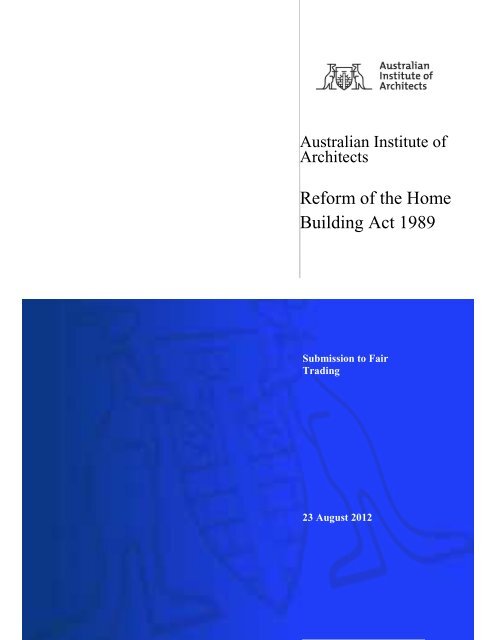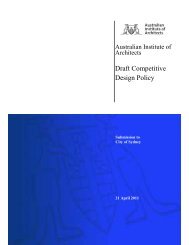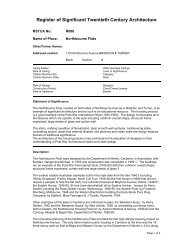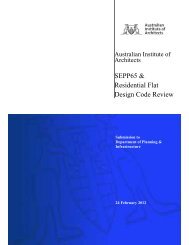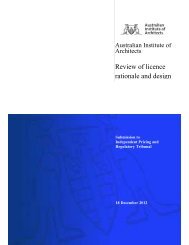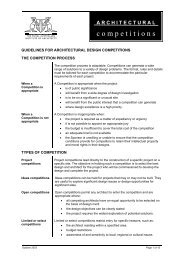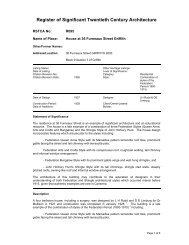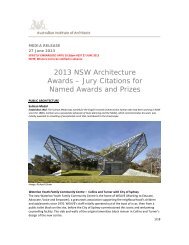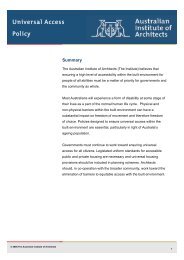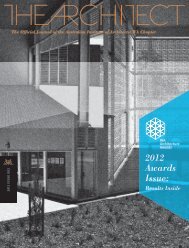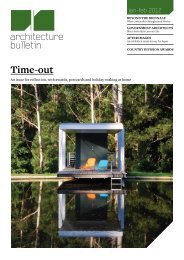Reform of the Home Building Act 1989 - Australian Institute of ...
Reform of the Home Building Act 1989 - Australian Institute of ...
Reform of the Home Building Act 1989 - Australian Institute of ...
Create successful ePaper yourself
Turn your PDF publications into a flip-book with our unique Google optimized e-Paper software.
<strong>Australian</strong> <strong>Institute</strong> <strong>of</strong><br />
Architects<br />
<strong>Reform</strong> <strong>of</strong> <strong>the</strong> <strong>Home</strong><br />
<strong>Building</strong> <strong>Act</strong> <strong>1989</strong><br />
Submission to Fair<br />
Trading<br />
23 August 2012
SUBMISSION BY<br />
<strong>Australian</strong> <strong>Institute</strong> <strong>of</strong> Architects – NSW Chapter<br />
ABN 72 000 023 012<br />
Tusculum, 3 Manning Street<br />
POTTS POINT NSW 2011<br />
Telephone: 02 9246 4055<br />
Facsimile: 02 9246 4030<br />
email: nsw@architecture.com.au<br />
PURPOSE<br />
<br />
<br />
<br />
This submission is made by <strong>the</strong> NSW Chapter <strong>of</strong> <strong>the</strong> <strong>Australian</strong> <strong>Institute</strong> <strong>of</strong><br />
Architects (<strong>the</strong> <strong>Institute</strong>) to Fair Trading in response to <strong>the</strong> <strong>Reform</strong> <strong>of</strong> <strong>the</strong><br />
<strong>Home</strong> <strong>Building</strong> <strong>Act</strong> <strong>1989</strong> Issues Paper.<br />
At <strong>the</strong> time <strong>of</strong> <strong>the</strong> submission <strong>the</strong> <strong>of</strong>fice bearers <strong>of</strong> <strong>the</strong> NSW Chapter are:<br />
Mat<strong>the</strong>w Pullinger (President), Brian Zulaikha (Immediate Past-President),<br />
Joe Agius, Nigel Bell, Shaun Carter, Emili Fox, Adam Haddow, David<br />
Holm, Esteban Insausti, Chris Jenkins, Alex Kibble, Stuart Landrigan,<br />
Louise Nettleton, Peter Sarlos, David Springett.<br />
The Office Manager <strong>of</strong> <strong>the</strong> NSW Chapter is Roslyn Irons. This paper was<br />
prepared by Murray Brown, Policy & Pr<strong>of</strong>essional Development Manager,<br />
Richard Barton, General Counsel and <strong>the</strong> NSW Chapter’s Practice<br />
Committee (chaired by Agi Sterling) for Chapter Council.<br />
INFORMATION<br />
Who is making this submission?<br />
The <strong>Australian</strong> <strong>Institute</strong> <strong>of</strong> Architects (<strong>the</strong> <strong>Institute</strong>) is an independent<br />
voluntary subscription-based member organization with approximately<br />
10,153 members who are bound by a Code <strong>of</strong> Conduct and Disciplinary<br />
Procedures.<br />
<br />
<br />
The <strong>Institute</strong>, incorporated in 1929, is one <strong>of</strong> <strong>the</strong> 96 member associations<br />
<strong>of</strong> <strong>the</strong> International Union <strong>of</strong> Architects (UIA) and is represented on <strong>the</strong><br />
International Practice Commission.<br />
The <strong>Institute</strong>’s New South Wales Chapter has 2,959 members, <strong>of</strong> which<br />
1,700 are registrable architect members – representing 56% <strong>of</strong> all<br />
registered architects in NSW.<br />
<strong>Australian</strong> <strong>Institute</strong> <strong>of</strong> Architects (NSW)<br />
<strong>Reform</strong> <strong>of</strong> <strong>the</strong> <strong>Home</strong> <strong>Building</strong> <strong>Act</strong> <strong>1989</strong><br />
23 August 2012<br />
i
Where does <strong>the</strong> <strong>Institute</strong> rank as a pr<strong>of</strong>essional association?<br />
At 10,153 members, <strong>the</strong> RAIA represents <strong>the</strong> largest group <strong>of</strong> nonengineer<br />
design pr<strong>of</strong>essionals in Australia.<br />
<br />
O<strong>the</strong>r related organisations by membership size include: The Design<br />
<strong>Institute</strong> <strong>of</strong> Australia (DIA) - 1,500 members; <strong>the</strong> <strong>Building</strong> Designers<br />
Association <strong>of</strong> Australia (BDAA) - 2,200 members; <strong>the</strong> <strong>Australian</strong> <strong>Institute</strong><br />
<strong>of</strong> Landscape Architects (AILA) 1,000 members; and <strong>the</strong> <strong>Australian</strong><br />
Academy <strong>of</strong> Design (AAD) - 150 members.<br />
<strong>Australian</strong> <strong>Institute</strong> <strong>of</strong> Architects (NSW)<br />
<strong>Reform</strong> <strong>of</strong> <strong>the</strong> <strong>Home</strong> <strong>Building</strong> <strong>Act</strong> <strong>1989</strong><br />
23 August 2012<br />
ii
<strong>Australian</strong> <strong>Institute</strong><br />
<strong>of</strong> Architects<br />
<strong>Reform</strong> <strong>of</strong> <strong>the</strong><br />
<strong>Home</strong> <strong>Building</strong><br />
<strong>Act</strong> <strong>1989</strong><br />
<strong>Australian</strong> <strong>Institute</strong> <strong>of</strong> Architects (NSW)<br />
<strong>Reform</strong> <strong>of</strong> <strong>the</strong> <strong>Home</strong> <strong>Building</strong> <strong>Act</strong> <strong>1989</strong><br />
23 August 2012<br />
1
REFORM OF THE HOME BUILDING ACT <strong>1989</strong><br />
RESPONSE TO ISSUES PAPER<br />
Question Topic<br />
Response<br />
Key issue 1: <strong>Home</strong><br />
building contracts<br />
1 Compliance with <strong>the</strong><br />
<strong>Building</strong> Code <strong>of</strong><br />
Australia<br />
2 Increase <strong>the</strong><br />
monetary threshold<br />
<strong>of</strong> <strong>the</strong> small jobs<br />
contract to $20,000<br />
3 Question 3:<br />
Progress payments /<br />
deposits<br />
Compliance with <strong>the</strong> minimum BCA standards to <strong>the</strong> extent that <strong>the</strong>y apply through <strong>the</strong> application <strong>of</strong><br />
any law, is fundamental. In addition, however, <strong>the</strong> required clause ought to state that, where <strong>the</strong><br />
contract documents require a standard higher than BCA, <strong>the</strong> work must comply with <strong>the</strong> specification.<br />
At <strong>the</strong> least, NSW Fair Trading inspectors must be mandated in <strong>the</strong>ir assessment to take account <strong>of</strong><br />
<strong>the</strong> standard <strong>of</strong> construction expressed in <strong>the</strong> contract documents, and not to rely on base level<br />
tolerances etc provided by regulation.<br />
The <strong>Institute</strong> agrees that this is appropriate.<br />
The <strong>Institute</strong> recognizes that <strong>the</strong> majority <strong>of</strong> builder/home owner projects do not provide for an<br />
independent contract administrator, such as a quantity surveyor or an architect, to determine <strong>the</strong><br />
appropriate amount <strong>of</strong> a payment made before <strong>the</strong> building work is complete. An independent contract<br />
administrator, such as <strong>the</strong> architect in a suitable contract, has <strong>the</strong> role <strong>of</strong> determining <strong>the</strong> appropriate<br />
level <strong>of</strong> completion when money is claimed by <strong>the</strong> builder and to issue a “progress certificate” that<br />
triggers corresponding payment obligations on <strong>the</strong> home owner. This mechanism facilitates home<br />
owners only paying for what has been completed at <strong>the</strong> date <strong>of</strong> a claim for payment. This mechanism<br />
can, if desired, accommodate deposits paid before work commences.<br />
<strong>Australian</strong> <strong>Institute</strong> <strong>of</strong> Architects (NSW)<br />
<strong>Reform</strong> <strong>of</strong> <strong>the</strong> <strong>Home</strong> <strong>Building</strong> <strong>Act</strong> <strong>1989</strong><br />
23 August 2012<br />
1
The <strong>Institute</strong> agrees that payment at recognised milestones <strong>of</strong> completion for home owners not using a<br />
contract providing for independent administration <strong>of</strong> progress claims, is an appropriate way to protect<br />
<strong>the</strong>m from overpayment, especially where a deposit is payable. However, this mechanism means that<br />
builders are foregoing <strong>the</strong> prompt payment which may have occurred at a monthly interval before<br />
completion stage is reached. Inevitably, this has an impact on <strong>the</strong> cost which is passed back to <strong>the</strong><br />
home owner in <strong>the</strong> contract price. Conversely, in situations such as renovation work, staged payments<br />
can mean that owners are paying too much compared to <strong>the</strong> work completed by <strong>the</strong> builder, because<br />
<strong>the</strong> description <strong>of</strong> <strong>the</strong> stage is inappropriate for <strong>the</strong> scope <strong>of</strong> work to be performed.<br />
An administered contract avoids <strong>the</strong> need for this cost impact, but we appreciate that not all home<br />
owners are in a position to engage a contract administrator such as an architect. We <strong>the</strong>refore<br />
propose that, if <strong>the</strong> milestone payment system is adopted, it is not mandatory, or, is only mandated<br />
with an exception to apply for independently administered contracts such as those where an architect<br />
is engaged. This is <strong>the</strong> system adopted in o<strong>the</strong>r jurisdictions such as Victoria and Queensland.<br />
4 Termination clauses The <strong>Institute</strong> supports <strong>the</strong> mandatory inclusion <strong>of</strong> termination clauses in contracts. To provide fairness<br />
and balance, it is appropriate for <strong>the</strong> clause to allow for assessment by an independent assessor <strong>of</strong><br />
moneys outstanding for work done, <strong>of</strong>fset against <strong>the</strong> independent assessor’s determination <strong>of</strong> <strong>the</strong><br />
reasonable cost <strong>of</strong> correction <strong>of</strong> defective work that would o<strong>the</strong>rwise have been rectified under <strong>the</strong><br />
contract, and which ought to be moneys owing.<br />
5 Cost-plus contracts The <strong>Institute</strong> agrees that this form <strong>of</strong> contract is ripe for difficulties because <strong>of</strong> <strong>the</strong> risk <strong>of</strong> cost blow-out<br />
involved. However, we accept that <strong>the</strong>re are some housing projects where costs are unknown.<br />
Renovation, conservation or refurbishment <strong>of</strong> an existing building are <strong>the</strong> usual situations because <strong>of</strong><br />
<strong>the</strong> difficulty <strong>of</strong> specifying <strong>the</strong> full scope <strong>of</strong> work at commencement.<br />
A cost plus contract is one way <strong>of</strong> dealing with this – although not <strong>the</strong> only one, as provisional or prime<br />
cost sum(s) in a fixed price contract may be sufficient to deal with <strong>the</strong> unknown factor(s). In <strong>the</strong><br />
example given in <strong>the</strong> Issues Paper, <strong>the</strong> need for excavation in traditional practice would have been<br />
dealt with in this way, by a substantial prime or provisional cost sum.<br />
<strong>Australian</strong> <strong>Institute</strong> <strong>of</strong> Architects (NSW)<br />
<strong>Reform</strong> <strong>of</strong> <strong>the</strong> <strong>Home</strong> <strong>Building</strong> <strong>Act</strong> <strong>1989</strong><br />
23 August 2012<br />
2
Key Issue 2:<br />
Statutory<br />
warranties<br />
6 Definition <strong>of</strong><br />
‘completion’ and<br />
subsequent<br />
purchasers.<br />
We also acknowledge that some home owners prefer <strong>the</strong> apparent flexibility <strong>of</strong> commencement before<br />
<strong>the</strong> plans and specifications are complete, along with <strong>the</strong> notion that <strong>the</strong> end cost will be lower if <strong>the</strong><br />
builder is not required to load up <strong>the</strong> contract price for unknowns. We recommend that If cost plus<br />
contracts are to be permitted <strong>the</strong>y ought to be:<br />
a limited to higher value wholly new homes, probably at a figure more like $750,000, or higher.<br />
(<strong>the</strong> limit set in Victoria at $500,000 is now many years old),and/or,<br />
b only be permitted in renovation, conservation or refurbishment <strong>of</strong> a home if <strong>the</strong>re is a<br />
demonstrable aspect <strong>of</strong> <strong>the</strong> project that creates uncertainty about <strong>the</strong> scope <strong>of</strong> work to be<br />
costed.<br />
We agree that under <strong>the</strong> new definition <strong>of</strong> completion, under most contracts without independent<br />
contract administration, completion and practical completion are simultaneous and final payment is<br />
<strong>the</strong>n due. In such cases, commencement <strong>of</strong> <strong>the</strong> statutory warranty period when <strong>the</strong> project can be<br />
used for its intended purpose and is free <strong>of</strong> major defects provides a workable basis for <strong>the</strong> original<br />
owner.<br />
However, we acknowledge <strong>the</strong> issue for <strong>the</strong> subsequent owner in that <strong>the</strong> date <strong>of</strong> completion under <strong>the</strong><br />
building contract may not be readily obtainable. If <strong>the</strong> date <strong>of</strong> completion for <strong>the</strong> original owner were to<br />
be practical completion but a different more identifiable date for subsequent owners were adopted, <strong>the</strong><br />
statutory warranty period is likely to be effectively extended, to <strong>the</strong> disadvantage <strong>of</strong> <strong>the</strong> building<br />
contractor.<br />
It is our understanding that in ordinary circumstances, <strong>the</strong> Occupation Certificate is issued reasonably<br />
soon after <strong>the</strong> building contract works are practically complete. The issue <strong>of</strong> <strong>the</strong> Occupation<br />
Certificate, which is a traceable document for subsequent owners to locate, could serve as <strong>the</strong><br />
mutually acceptable trigger point for <strong>the</strong> statutory warranties without substantial disadvantage to<br />
contractors.<br />
<strong>Australian</strong> <strong>Institute</strong> <strong>of</strong> Architects (NSW)<br />
<strong>Reform</strong> <strong>of</strong> <strong>the</strong> <strong>Home</strong> <strong>Building</strong> <strong>Act</strong> <strong>1989</strong><br />
23 August 2012<br />
3
8 Maintenance<br />
schedule<br />
9 Owner’s<br />
maintenance<br />
obligations<br />
10 Definition <strong>of</strong><br />
‘structural defects’<br />
This requirement should apply to all strata scheme buildings. <strong>Building</strong>s simply are not maintenancefree.<br />
Yes, for <strong>the</strong> same reasons as above<br />
We appreciate <strong>the</strong> distinction between structural and detail/aes<strong>the</strong>tic defects, but all defects arising<br />
from breach <strong>of</strong> <strong>the</strong> statutory warranties should be rectified. We support <strong>the</strong> proposal <strong>of</strong> <strong>the</strong> Minister for<br />
Fair Trading’s <strong>Home</strong> <strong>Building</strong> Advisory Council for a 2 category system similar to <strong>the</strong> Queensland<br />
model.<br />
11 Statutory warranties The <strong>Institute</strong> considers that in <strong>the</strong> ordinary course <strong>of</strong> home building, <strong>the</strong> statutory warranties are<br />
adequate, given that <strong>the</strong> usual warranties are applicable whe<strong>the</strong>r or not stated in <strong>the</strong> contract.<br />
12 Defences to<br />
statutory warranties<br />
Key Issue 3:<br />
Dispute Resolution<br />
13 Compel<br />
homeowners to<br />
allow licensees back<br />
on site to rectify<br />
defects<br />
14 Complaint<br />
Inspection Advices<br />
15 Non-compliance<br />
with rectification<br />
orders<br />
We are not in a position to comment on <strong>the</strong> suitability <strong>of</strong> <strong>the</strong> defences available to builders, except to<br />
note that it is appropriate that it continue to be a defence that <strong>the</strong> owner has insisted on a particular<br />
material or solution against <strong>the</strong> builder’s advice.<br />
<strong>Institute</strong> members are not commonly exposed to <strong>the</strong> situation where rectification orders are required,<br />
because architect-administered contracts almost invariably involve a defects liability period post<br />
practical completion, in which defective or incomplete work is to be fixed/completed before <strong>the</strong> contract<br />
is at an end and <strong>the</strong> final contract payment is due. However, where rectification orders are required, it<br />
seems only logical, and fair to contractors, that home owners ought to be compelled to allow access,<br />
as long as <strong>the</strong>re is not a personal or property safety issue.<br />
Once an agreement to be reflected in <strong>the</strong> Complaint Inspection Advice is reached, or a Rectification<br />
Order is made instead, it seems logical that <strong>the</strong>re be a requirement to both comply and to comply<br />
within time limits.<br />
We support <strong>the</strong> proposal to compel compliance with a Rectification Order, or Complaint Inspection<br />
Advice, as a means <strong>of</strong> achieving <strong>the</strong> outcome <strong>of</strong> rectification.<br />
<strong>Australian</strong> <strong>Institute</strong> <strong>of</strong> Architects (NSW)<br />
<strong>Reform</strong> <strong>of</strong> <strong>the</strong> <strong>Home</strong> <strong>Building</strong> <strong>Act</strong> <strong>1989</strong><br />
23 August 2012<br />
4
16 Disputes over<br />
$500,000<br />
17,18 Alternative dispute<br />
resolution processes<br />
<strong>Australian</strong> <strong>Institute</strong> <strong>of</strong> Architects (NSW)<br />
<strong>Reform</strong> <strong>of</strong> <strong>the</strong> <strong>Home</strong> <strong>Building</strong> <strong>Act</strong> <strong>1989</strong><br />
23 August 2012<br />
We agree that Fair Trading should promote its services as alternatives, but note that once <strong>the</strong> amount<br />
in dispute becomes substantial, it is only to be expected that <strong>the</strong> parties will have legal advisers, and<br />
that alternative dispute resolution will have been in contemplation, under advice.<br />
The <strong>Institute</strong> supports alternative dispute resolution systems and <strong>the</strong>ir promotion within <strong>the</strong> courts.<br />
The Land & Environment Court is a model in this regard. It requires intending litigants to go down an<br />
alternative dispute resolution track that <strong>of</strong>ten resolves disputes before litigation.<br />
Key Issue 4: Owner<br />
Builders<br />
19-26 The <strong>Institute</strong> generally agrees with <strong>the</strong> views <strong>of</strong> <strong>the</strong> <strong>Home</strong> <strong>Building</strong> Advisory Panel in relation to <strong>the</strong>se<br />
questions.<br />
Key Issue 5:<br />
Disciplinary<br />
Provisions<br />
Questions 27-30<br />
We agree that effective regulation is essential and support <strong>the</strong> proposals to streng<strong>the</strong>n enforcement to<br />
achieve this.<br />
Key Issue 6: <strong>Home</strong><br />
warranty Insurance<br />
31 Comparative models The <strong>Institute</strong> has no issues with <strong>the</strong> current model in NSW being inadequate compared to o<strong>the</strong>r<br />
jurisdictions.<br />
32 Extended cover for<br />
new rectification<br />
work<br />
For <strong>the</strong> same reasons as <strong>the</strong> cover was initially required, new rectification work <strong>of</strong> significant value<br />
performed near <strong>the</strong> end <strong>of</strong> <strong>the</strong> period should be under extended cover.<br />
33 Searchable public<br />
register<br />
A searchable public register would appear to assist as it would avoid both fraud and loss <strong>of</strong> certificate<br />
issues.<br />
34 Cover cap levels No comment<br />
35 Renaming <strong>of</strong><br />
scheme<br />
We agree it should be renamed as it causes confusion because it is not consistent with <strong>the</strong> ordinary<br />
understanding <strong>of</strong> insurance.<br />
36 Exemptions from<br />
home warranty<br />
This exemption needs to dovetail with SEPP65 provisions for multi-residential buildings so that <strong>the</strong> use<br />
<strong>of</strong> <strong>the</strong> SEPP is <strong>the</strong> trigger for <strong>the</strong> exemption. This would avoid different definitions around exemptions<br />
5
insurance<br />
37 Clarification <strong>of</strong><br />
definition <strong>of</strong> ‘storey’<br />
for <strong>the</strong> purposes <strong>of</strong><br />
determining <strong>the</strong> high<br />
rise exemption<br />
for multi-storey residential developments in <strong>the</strong> industry and at <strong>the</strong> same time distinguish <strong>the</strong> issue <strong>of</strong><br />
new work from refurbishment. In <strong>the</strong> <strong>Institute</strong>’s view, refurbishment involving renovation and<br />
maintenance which happens to be in a 3 or more storey building, but is in possession <strong>of</strong> <strong>the</strong> owner,<br />
ought to have <strong>the</strong> same safety net protection as renovation or refurbishment ‘at ground level’.<br />
In our view, use <strong>of</strong> <strong>the</strong> SEPP criteria would trigger <strong>the</strong> exemption. The definition in <strong>the</strong> SEPP is:<br />
‘residential flat building means a building that comprises or includes:<br />
(a) 3 or more storeys (not including levels below ground level provided for car parking or storage, or<br />
both, that protrude less than 1.2 metres above ground level), and<br />
(b) 4 or more self-contained dwellings (whe<strong>the</strong>r or not <strong>the</strong> building includes uses for o<strong>the</strong>r purposes,<br />
such as shops)’<br />
38 Definition <strong>of</strong> storey No comment<br />
39 Repeal <strong>of</strong> s.92B No comment<br />
40 Eligibility criteria Eligibility should generally be determined by <strong>the</strong> insurer according to risk. However, risk management<br />
should not cross into detriment to o<strong>the</strong>rs operating in <strong>the</strong> industry, as has been <strong>the</strong> case with private<br />
insurers in <strong>the</strong> past. Specifically, private insurers were deterring some contractors from tendering for,<br />
or working on, architect designed/administered projects under what <strong>the</strong> <strong>Institute</strong> believes is a<br />
misconception.<br />
41 Definition <strong>of</strong> ‘Cannot be found in Australia’ is a more logical statutory definition.<br />
“disappeared”<br />
42 Top up insurance No comment<br />
<strong>Australian</strong> <strong>Institute</strong> <strong>of</strong> Architects (NSW)<br />
<strong>Reform</strong> <strong>of</strong> <strong>the</strong> <strong>Home</strong> <strong>Building</strong> <strong>Act</strong> <strong>1989</strong><br />
23 August 2012<br />
6


